Have you ever wondered if the ground beneath your feet could power devices? An earth battery taps into natural energy stored in the soil, offering a sustainable alternative to traditional power sources. This simple yet innovative technology uses metal electrodes buried in the ground to generate usable energy.
These batteries work by capturing the small voltage differences between layers of soil or moisture. While not as powerful as conventional options, they provide a reliable way to generate off-grid power. Best of all, they require minimal maintenance and no fuel.
In this guide, we’ll explore how these unique electrical systems function. You’ll also learn how to build one yourself and discover real-world applications. Whether you’re a DIY enthusiast or just curious about green energy, this is a fascinating concept worth exploring.
Key Takeaways
- Earth batteries use natural ground energy to produce power.
- They rely on metal electrodes placed in soil to generate voltage.
- These systems are eco-friendly and require no fuel.
- They work best in moist, mineral-rich soil conditions.
- DIY versions can power small devices like sensors or lights.
Understanding Earth Electricity: The Basics
Soil isn’t just for plants; it can also generate small but steady electrical currents. This natural energy, often overlooked, stems from chemical reactions and environmental factors beneath our feet. Let’s break down how it works and why it matters.
What Is Earth Electricity?
Earth electricity refers to the current flow naturally present in the ground. It’s created by electrochemical imbalances between soil layers, moisture, and dissolved minerals. Unlike man-made power, this energy is passive but persistent.
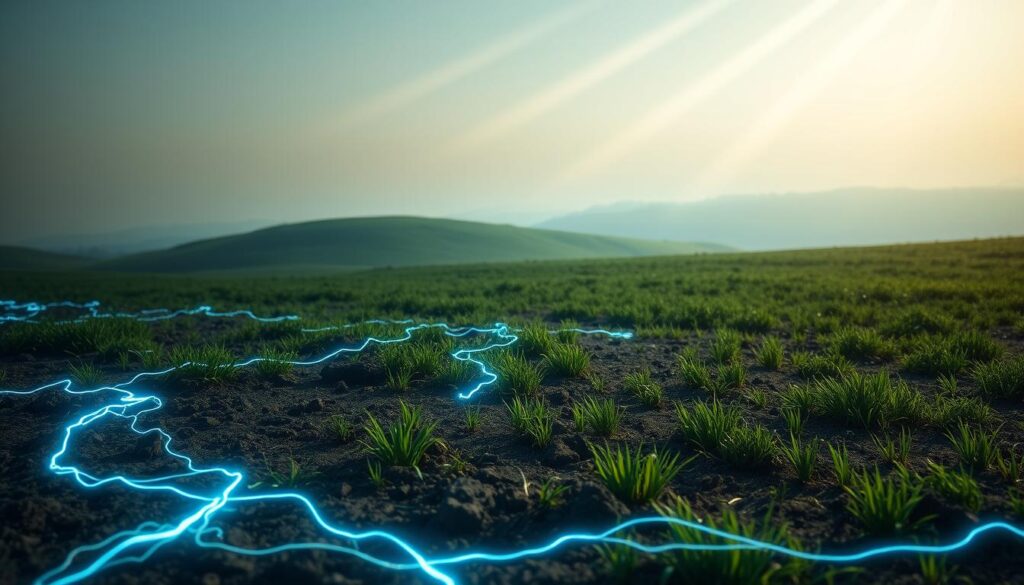
How Natural Currents Flow Through the Ground
Conductivity depends on soil composition. Wet, mineral-rich dirt enhances electrical current, while dry or sandy soil reduces it. Temperature shifts and microbial activity also play roles.
External forces like lightning strikes or solar radiation amplify these currents. Historically, telegraph systems used the ground as a reference point to complete circuits—proof of its practical potential.
Compared to conventional grids, earth’s energy is weaker but sustainable. It’s a quiet powerhouse, ideal for low-voltage applications like sensors or emergency signals.
The Science Behind Grounding and Earth Connections
Grounding isn’t just a technical term—it’s a lifesaver. By creating a safe path for excess current, it prevents shocks and fires. This section dives into why grounding matters and how it stabilizes electrical systems.
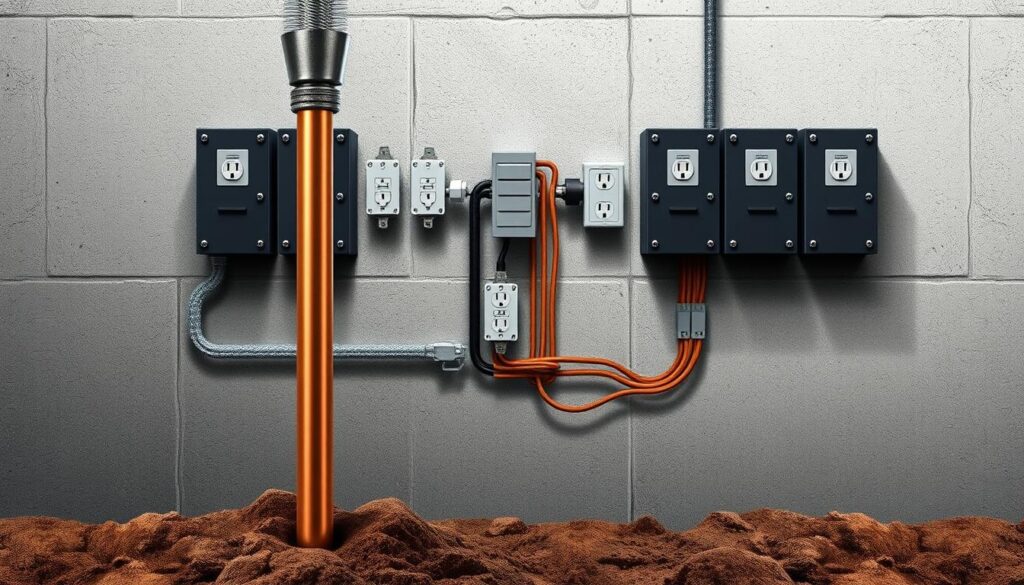
Why Grounding Is Essential for Safety
Grounding redirects dangerous faults into the soil, shielding people and devices. For example, a frayed wire in an appliance could electrify its metal casing. Without grounding, touching it might be deadly.
Copper rods and wiring form the backbone of these systems. Buried deep, they ensure surges from lightning or short circuits dissipate harmlessly. The IEC 60417 standard defines universal symbols for proper electrical safety practices.
Earth as a Reference Point in Circuits
In any circuit, voltage needs a baseline to measure against. The ground acts as this neutral reference point, keeping signals stable. Telecommunication towers and power grids rely on this principle.
Improper grounding can cause ground loops—a mismatch in voltage that disrupts signals. Symptoms include humming audio or flickering lights. Always consult an electrician to avoid these risks.
- Key risks of poor grounding: Shock hazards, equipment damage, data corruption.
- IEC standards: Ensure compliance for safe installations.
What Is an Earth Battery?
Long before solar panels, innovators tapped into the ground’s hidden energy. An earth battery converts natural soil currents into usable power. It’s a simple device—metal electrodes buried in damp dirt—yet it’s fueled everything from telegraphs to garden lights.

Definition and Historical Use
These batteries rely on electrolytes in soil, not chemicals. Early telegraph systems used them as a return path for signals.
“The earth itself completed the circuit, cutting costs for wire networks.”
By the 1840s, rural areas powered telegraph stations with buried copper and zinc plates. The voltage was low but steady, proving dirt could be a power supply.
How It Differs from Conventional Batteries
Unlike lithium-ion or alkaline batteries, earth versions need no toxic materials. They’re maintenance-free and thrive in wet, mineral-rich soil. Here’s how they stack up:
| Feature | Earth Battery | Conventional Battery |
|---|---|---|
| Materials | Soil, metal electrodes | Lithium/cadmium |
| Sustainability | Zero waste | Recycling needed |
| Power Output | Low (0.5–2V) | High (1.5–12V) |
Today, they’re ideal for electrical equipment like soil sensors or emergency beacons. Their historical use paved the way for off-grid energy experiments.
How Does an Earth Battery Work?
Hidden beneath the soil lies a natural power source waiting to be tapped. By harnessing reactions between metal and moisture, these batteries produce steady, low-level voltage. Here’s the science behind it.

The Role of Electrodes and Soil Composition
Two metal rods—like copper and zinc—act as electrodes. When buried in damp soil, they react with electrolytes (salts and acids) in the ground. This creates an electrical current through a process called galvanic corrosion.
Soil composition directly impacts output. Ideal conditions include:
- High moisture (water helps ions move freely).
- Balanced pH (neutral to slightly acidic).
- Mineral-rich dirt (clay or loam works best).
Voltage Flow in Earth Batteries
Each electrode pair generates 0.5V–1.5V, depending on materials and environment. Copper-zinc combos often yield higher voltage than iron due to their electrochemical properties.
For more power, link multiple cells in series. This stacks their voltage, similar to traditional batteries. Below, see how common metals compare:
| Electrode Pair | Avg. Voltage Output | Best Soil Type |
|---|---|---|
| Copper-Zinc | 1.1V | Clay/Wet |
| Iron-Copper | 0.7V | Loam/Damp |
| Aluminum-Zinc | 0.9V | Mineral-rich |
While single cells power small sensors, multi-cell setups can run LED lights or radios. Just remember: output depends on consistent current flow through the soil.
Types of Earth Batteries
Not all batteries need chemicals—some thrive in the dirt. Depending on your needs, you can choose from basic single-cell designs or advanced multi-cell systems. Each type offers unique benefits for low-energy applications.
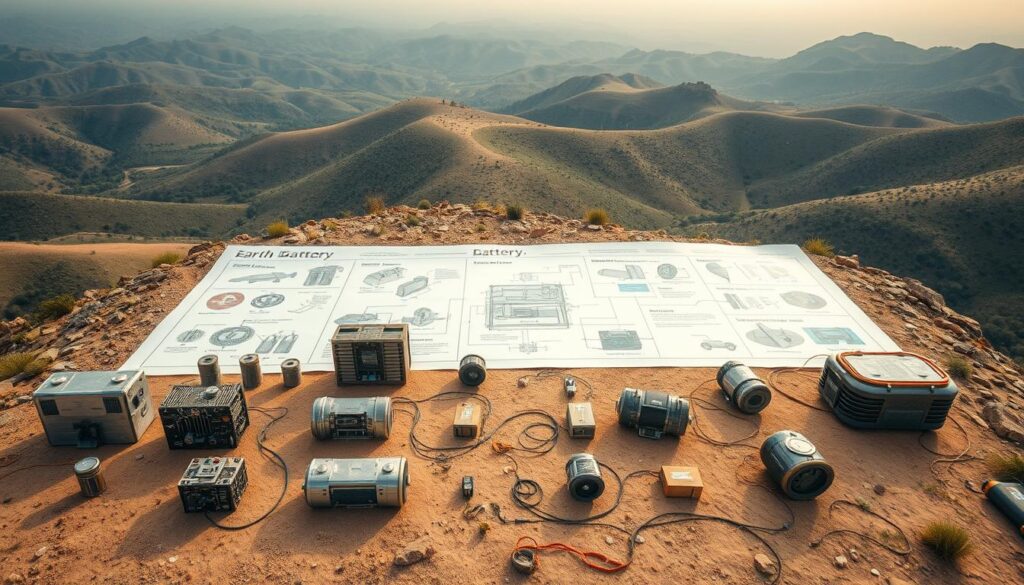
Simple Single-Cell Designs
A single-cell setup uses two metal rods buried in soil. Copper and zinc are common choices, generating around 0.5V–1V. These are perfect for small projects like garden sensors.
Single-wire earth return (systems) simplify wiring by using the ground as a conductor. They’re cost-effective but work best in moist, mineral-rich dirt.
Multi-Cell and Enhanced Configurations
For more power, link cells in series. Stacking four copper-zinc pairs can produce up to 4V—enough for LED lights or emergency radios. Parallel connections increase current instead of voltage.
Hybrid designs add solar panels or capacitors for stability. These systems compensate for soil dryness or low output. However, scaling up remains tricky due to space and soil limitations.
Materials Needed to Build an Earth Battery
Copper, zinc, and soil—these are the building blocks of an earth battery. With a handful of simple components, you can create a low-cost power source. Here’s what you’ll need to get started.

Essential Components
Gather these items before digging in:
- Copper rods or plates: Ideal for positive electrodes due to high conductivity.
- Zinc plates: Paired with copper for optimal voltage output.
- Insulated wire (12-gauge copper recommended) to minimize resistance.
- A voltmeter to measure output.
- Moist, mineral-rich soil (clay or loam works best).
For safety, use a non-conductive container like plastic to house the setup. Optional additives like charcoal can boost soil conductivity.
Choosing the Right Electrodes
Not all metal pairs work equally well. Copper-zinc combos are cost-effective and efficient, generating ~1.1V. Iron or aluminum are cheaper but yield lower voltage.
Here’s a quick comparison:
| Electrode Pair | Voltage Output | Cost |
|---|---|---|
| Copper-Zinc | 1.1V | $$ |
| Iron-Copper | 0.7V | $ |
For DIY projects, copper and zinc strike the best balance between power and affordability.
Step-by-Step Guide to Building Your Earth Battery
Ready to harness nature’s hidden power? Building an earth battery is simpler than you think. With a few materials and careful steps, you’ll tap into sustainable energy in no time.

Preparing the Site and Materials
Choose a damp, shaded spot—moist soil boosts conductivity. Gather copper and zinc rods, insulated wire, and a voltmeter. Safety precautions matter: wear gloves and use an RCD/GFCI device to prevent shocks.
Assembling the Battery
Bury electrodes 12–24 inches apart. Copper and zinc pairs work best. Connect wires securely to each grounding electrode, ensuring no exposed metal. Star-point grounding avoids disruptive loops.
Testing and Optimizing
Check voltage with a multimeter. Low output? Add water or adjust electrode depth. For electrical equipment like sensors, ensure stable flow by testing physical connections regularly.
Practical Applications of Earth Batteries
Forget outlets—these batteries turn dirt into a silent power source. From backyard gadgets to emergency setups, they offer clever solutions where traditional energy falls short.
Low-Power Devices and Sensors
Earth batteries shine in running small, energy-efficient tools. Weather stations, soil moisture sensors, and wildlife cameras thrive on their steady output. These setups are ideal for remote monitoring without grid access.

Garden lights are another perfect match. They need minimal voltage, and the soil’s natural conductivity keeps them glowing nightly. IoT devices, like environmental sensors, also benefit from this sustainable approach.
Emergency and Off-Grid Power
When storms knock out power, these batteries become lifesavers. They can charge:
- Emergency radios for weather alerts.
- LED lamps for nighttime safety.
- Backup batteries for critical sensors.
Pairing them with solar panels creates hybrid off-grid power systems. This combo ensures reliability in disaster-prone areas. However, high-energy devices like smartphones remain beyond their reach—stick to low-power needs for best results.
From reducing waste to cutting energy costs, these batteries prove that sustainability starts right underfoot.
Advantages of Using Earth Batteries
Sustainable energy isn’t just about solar or wind—it’s underfoot. These humble power sources tap into the ground’s natural properties, offering unique perks for eco-friendly tech. Whether you’re off-grid or just curious, here’s why they stand out.

Sustainability and Environmental Benefits
Earth batteries leave almost no footprint. Unlike conventional options, they produce zero emissions and need no toxic chemicals. Their materials—copper, zinc, and soil—are recyclable or naturally abundant.
They’re perfect for low-impact projects like garden sensors or educational kits. Environmental benefits extend to reduced e-waste, since they outlast many disposable batteries with proper care.
Cost-Effectiveness
Building one costs pennies compared to lithium-ion packs. Basic setups need just scrap metal and insulated wire. No fuel or complex maintenance means long-term savings.
For DIYers, they’re a wallet-friendly gateway to renewable energy experiments. Schools and hobbyists love their simplicity and cost-effectiveness.
- Zero ecological disruption: Works with existing soil.
- Minimal upkeep: No charging or replacements.
- Educational value: Teaches green energy principles.
Limitations and Challenges
Sustainable power from soil sounds ideal, but real-world use has constraints. While earth batteries excel in eco-friendliness, their power output and reliability face natural barriers. Understanding these challenges helps set realistic expectations for DIY projects and commercial applications alike.
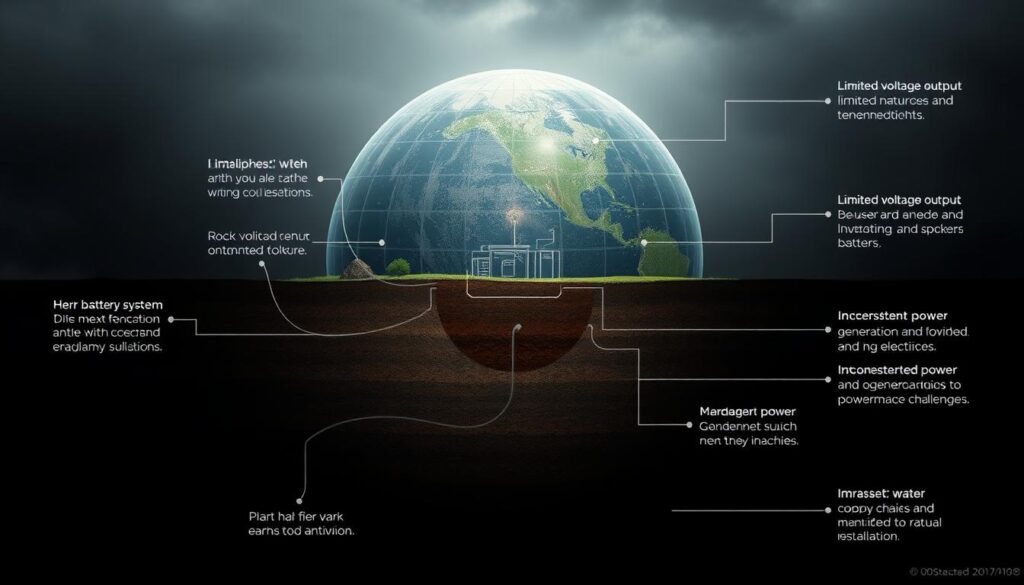
Power Output Constraints
These systems typically generate less than 2V per cell—enough for sensors but inadequate for high-demand devices. A copper-zinc pair might power an LED light, yet struggle with smartphones or tools. Voltage drops further when linking multiple cells due to internal resistance.
Three key factors limit energy production:
- Electrode materials (copper-zinc yields ~1.1V)
- Distance between rods (optimal spacing reduces resistance)
- Soil conductivity (moisture and minerals boost current flow)
Environmental Factors Affecting Performance
Droughts freeze output as dry soil hampers conductivity. Frozen ground behaves similarly, while highly alkaline earth accelerates electrode corrosion. Geographic differences in soil composition mean coastal clay outperforms desert sand.
Consider these environmental factors when planning installations:
| Condition | Impact | Solution |
|---|---|---|
| Dry soil | Reduces current by 60-80% | Add water or organic matter |
| High pH (>8.5) | Corrodes zinc electrodes faster | Use corrosion-resistant coatings |
| Low temperatures | Slows ion movement | Bury deeper below frost line |
Regular maintenance—like checking connections and moisture levels—helps sustain performance. While not perfect for all scenarios, these batteries fill niche roles where sustainability outweighs raw power needs.
Safety Measures When Working with Earth Batteries
Safety should always come first when experimenting with alternative power sources. While earth batteries are generally low-risk, proper safety measures prevent accidents and ensure reliable operation. These simple precautions protect both you and your equipment.
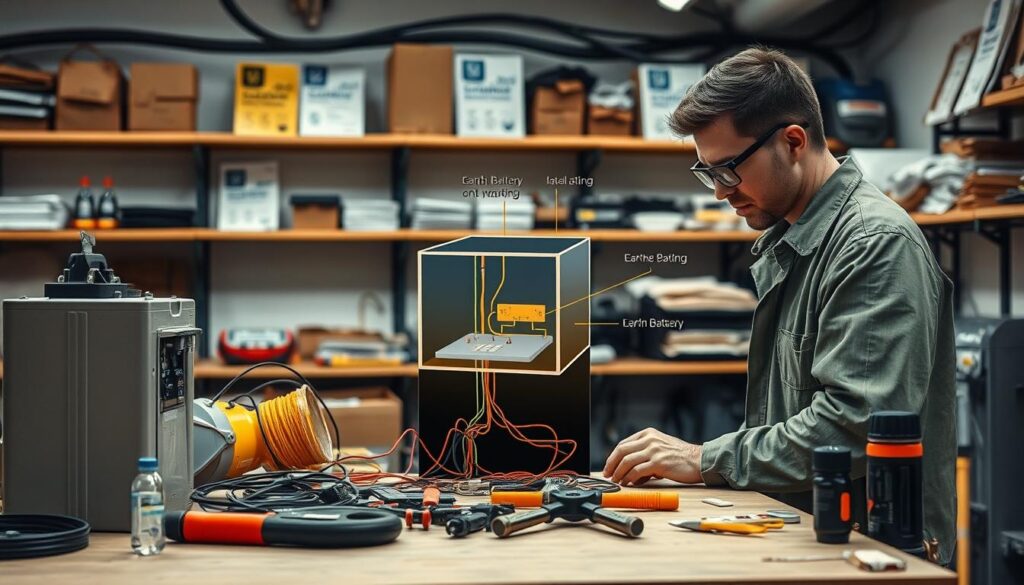
Electrical Safety Precautions
Even low-voltage systems require careful handling. Always wear insulated gloves when assembling or adjusting your setup. This prevents accidental shocks from unexpected current flow.
Use GFCI (Ground Fault Circuit Interrupter) outlets for outdoor projects. These devices instantly cut power if they detect dangerous leaks. For extra protection, consider an RCD (Residual Current Device) in your circuit.
Key safety checks include:
- Inspecting wire insulation regularly for damage
- Keeping the installation area dry when possible
- Marking buried components to avoid accidental contact
Preventing Ground Loops and Interference
Ground loops occur when multiple grounding points create conflicting paths. These can disrupt your system and nearby electronics. Star-point grounding solves this by connecting all wires to a single connected earth point.
Separate your earth battery ground from home wiring systems. This isolation prevents interference with household appliances. For best results, place electrodes at least 10 feet from other grounded objects.
Remember these tips to minimize issues:
- Use twisted-pair wiring to reduce electromagnetic interference
- Check for voltage fluctuations with a multimeter
- Keep your setup away from underground utilities
Conclusion
Harnessing natural energy doesn’t always require high-tech solutions. Earth batteries prove that even the ground beneath us can power small devices sustainably. These low-cost systems shine in off-grid settings, offering environmental benefits without complex maintenance.
For those exploring green energy, start small. A DIY project can teach the basics of sustainability while powering garden lights or sensors. Pair it with off-grid power systems for hybrid reliability.
Always prioritize safety—check connections and keep setups dry. Though limited in output, these batteries inspire innovation. Ready to experiment? The future of energy might just be underfoot.

